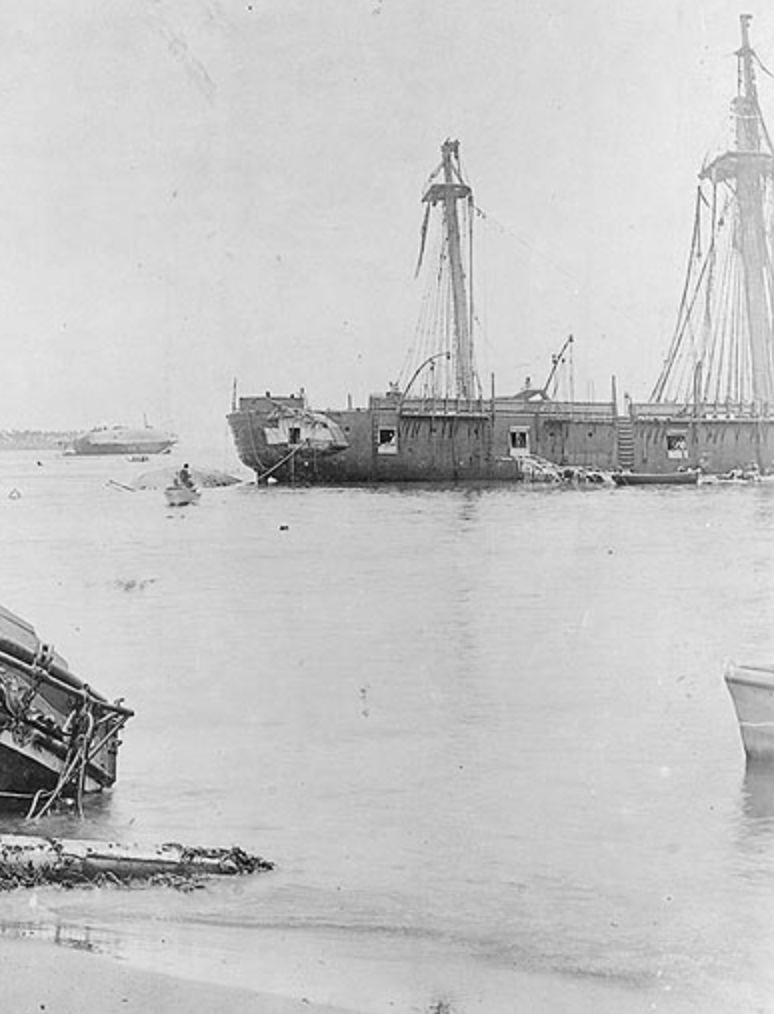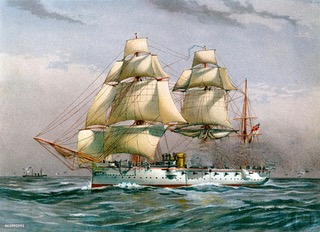
Samoan leadership
There are four leading families in the Samoan Islands,
Tupua Tamasese, Malietoa, Mata'afa and Tuimaleali'ifano,
each lead by a Tama-a-Aiga, who is responsible
for the well-being of the extended family and the
protection of its customary land. One of the four
tama-a-ainga is chosen as head of state (king/queen). |
 View from Muliva'ai Point before the hurricane |
Then on the 13th, the ships' barometers began dropping rapidly eventually reaching 985 mbar, and navigation officers warned they must head out to sea to avoid being wrecked by the high winds. But Admiral Kimberly refused to let neither his battle fleet leave port, nor any US merchant vessel, and the German commander followed suit.
The high winds broke the anchor cables of the ships and they crashed into each other then capsized and started breaking up, or were ran ashore, except the HMS Calliope. This British ship, with its 4000 horsepower engine fired by bitumenous coal from Westport NZ, managed to steam out of the narrow harbour entrance in the face of 150 kph winds and mountainous waves. All the other vessels ended up on the reef at the south end of the harbour.

Rescue
 These other warships were forced onto the rocks by the
great winds and huge waves, and they started breaking
up, drowning more than 90 on the German vessels and 50
on the American ones, leaving hundreds more American
seamen clinging to the battered hulk of the Trenton
(left) about 100 metres offshore.
These other warships were forced onto the rocks by the
great winds and huge waves, and they started breaking
up, drowning more than 90 on the German vessels and 50
on the American ones, leaving hundreds more American
seamen clinging to the battered hulk of the Trenton
(left) about 100 metres offshore.Seeing the danger these men were in, high chief Seumanatafa summoned his men to the shore, where they formed a human chain across the raging waters to the Trenton, heroically rescuing more than 350 men, whom his wife Fa’atulia led the village women in reviving.
These rescued men spent several months recuperating in the homes of villagers in Apia. When they left to return to the USA, Faatui Fuimaono Voa composed this song as a farewell to his American friends, and it eventually became established as Samoa's farewell anthem.
The hurricane abruptly ended the conflict, and Malietoa Laupepa was appointed king.
|
NEW ZEALAND
FOLK
* SONG
|
The
Hurricane Jumper
Alan Knight 2020 |
Am In those days of conquest we C watched and we G wondered,
How Am swiftly the old ways gave C way to the G new.
And the Am tall ships we sailed in grew C sleeker and G faster
the Am further to sail as the Em empire Am grew.
Now a sailor needs canvas above his head filling
it's rigging we trust on each towering mast.
But the admirals dreamed of the steam engine's glory
and slowly our ships they grew fast beating hearts.
Chorus
So
C
let your sails fill with the G
wind's deadly fury
and Am stoke up the fires when the C hurricanes G blow,
for 'The Am Jumper' will ride any C storm you can G send her
with a Am coal driven heart that's a' Em beating Am below.
and Am stoke up the fires when the C hurricanes G blow,
for 'The Am Jumper' will ride any C storm you can G send her
with a Am coal driven heart that's a' Em beating Am below.
There were two of her class built to sail down the sea lanes
our trade to protect to the ends of the line.
The barque rigged Calliope near three thousand long tons
of steel bounded timber and rigging so fine.
While under her deck there lay two great steam engines
all driving their power into one single screw.
And all round her keel she was bounded in copper
and never a ship sailed so straight or so true.
Chorus
When first we set sail in eighteen eighty seven,
to Singapore Station our orders they came.
Then off to New Zealand to lay in provisions,
and into the dry dock that bore our ships' name.
Let's all bless the day when we got to New Zealand,
eight days 'cross the Tasman it took us to roll.
And there on the quay side at Devonport harbour
we filled up her bunkers with fine Stockton coal.
Chorus
In March '89 boys that coal was our saviour
on that black day in Apia as the storm it drew near.
Full thirteen fine ships in that small crowded mooring
and every ship's master made plans to sail clear.
A curse on their pride though, for no man would break first,
and make for the sea as the hurricane grew.
The Germans and Yankees stayed fast to their anchors,
but Calliope's captain he called to his crew;
Chorus II
'Let
our sails fill with the wind's deadly fury
now stoke up the fires and make ready to go,
for this ship she will ride any storm you can send her
now stoke up the fires and make ready to go,
for this ship she will ride any storm you can send her
with
that coal-driven heart you hear beating
below!'
The Calliope shook as she strained 'gainst her anchors,
we aimed for the ocean we barely could see,
then at last Captain Kane gave the orders to cut loose
our anchor chains, setting our mighty ship free.
It might have been minutes it might have been hours
that we fought our way clear of Apia's shoal.
And for two days at sea we rode out that fierce storm,
pushed on by the heat of that dark Stockton coal.
Chorus
By the time we returned to Samoa's small harbour
those other twelve ships were all wrecked on the shore.
Two hundred were lost to the hurricane's fury
two hundred brave seamen who'll sail home no more.
We gave help where we could then we sailed back to Sydney,
Our ship brought us through and lost only one soul.
And when 'Hurricane Jumper' she made Garden Island
we all raised a toast to that fine Stockton coal!
Chorus
II
And we raised a toast to those two hundred seamen
who drowned there that day for no cause they could see.
For they won't be the last while men still have the notion,
of painting their flags on the pitiless sea.
Chorus
HMS Calliope
The 19th century British Empire was the most extensive on Earth, and Britain protected that empire and its trade routes with the world's largest navy. Calliope and its sister ship Calypso were corvettes designed to operate across the vast distances of Britain's maritime empire and not have to rely on dry docks for maintenance. Since steel hulls were subject to fouling and could not easily be cleaned, the established practice of copper sheathing was extended to protect them; the metal plating of the hull was timber-cased and coppered below the waterline.

Its 4-cylinder, compound-expansion,
J. and G. Rennie steam engine was supplied with steam by six boilers and developed 4,023 horsepower. This engine was 50% more powerful than those on previous vessels, giving an extra 2 kph of speed, a difference that would be crucial in the disaster that made Calliope famous. The engine drove a single feathering screw, and enabled the vessel to reach a speed of 28 kph with forced draught.
A 3-cylinder expansion engine is shown here.

It was also a fully rigged sailing ship, allowing sustained service in areas where coaling stations were far apart. It was activated for service in January 1887 when the vessel was placed in commission for the China Station. Captain Henry Kane took Calliope to Singapore, then Australia, and at the end of that year it was the first vessel to enter the new Calliope Dock at Auckland.
In March 1889, it joined the competing squadrons of the Imperial German and United States navies at Apia, in order to keep the peace there. Apia harbour was small and nearly surrounded by reefs. Fit for about four ships, the anchorage was holding seven warships and six merchant vessels when the barometer began to fall. Over the next two days winds of 130–185 kph blew directly into the anchorage, trapping the ships. Operating their engines at full speed, ships nevertheless dragged their anchors and were driven landward. Vessels collided and were thrown on the reefs or ashore, and some sank. Calliope, still riding at anchor and only 6 metres away from the coral reef, was hit by one ship and narrowly missed by another, so Captain Kane began an attempt to escape. Ahead were two US warships, to starboard were other warships. There was only a narrow opening between the vessels on one side and the reef on the other. With the rudder at times within 2 metres of the reef, Captain Kane saw an opening and drove forward, cheered on by seamen on the adjacent USS Trenton.
 Making
for the narrow harbour mouth, the British ship's bow and
stern alternately rose and plunged, the propeller at
times spinning in air, requiring a careful hand on the
throttle to keep the shaft from running away to
destruction. There were ten men on the wheel and more
below handling relieving tackle on the tiller to assist
in maintaining control of the rudder. Taking two hours
to travel less than one kilometre to the harbour mouth,
they finally escaped the anchorage into the open sea.
Making
for the narrow harbour mouth, the British ship's bow and
stern alternately rose and plunged, the propeller at
times spinning in air, requiring a careful hand on the
throttle to keep the shaft from running away to
destruction. There were ten men on the wheel and more
below handling relieving tackle on the tiller to assist
in maintaining control of the rudder. Taking two hours
to travel less than one kilometre to the harbour mouth,
they finally escaped the anchorage into the open sea. After returning to Apia harbour and assisting with rescue work, Captain Kane then took his ship to Sydney, where they received a hero's welcome. The narrowness of Calliope's escape, the excellence of the engines and the dedication of the crew, the seamanship of Captain Kane and officers, trusting only in their ship and themselves, and the encouragement and respect given to them by other seamen made Calliope famous.
Summarised from Wikipedia
Placed on folksong.org.nz in April 2021
Hurricane Jumper added October 2023
